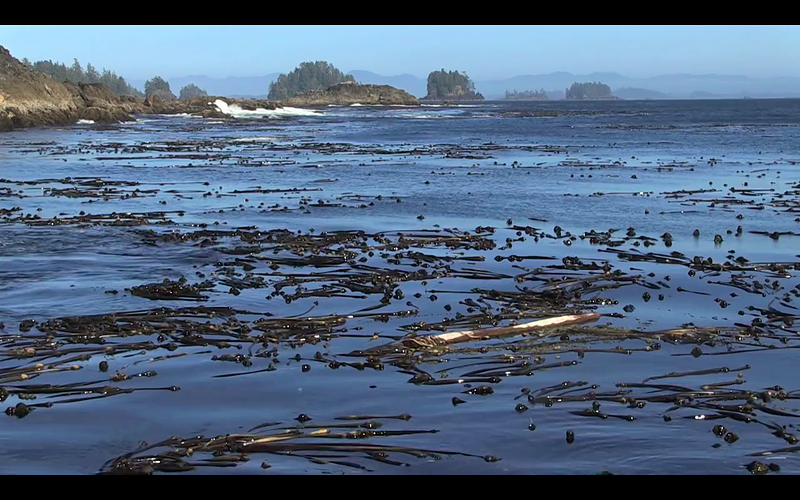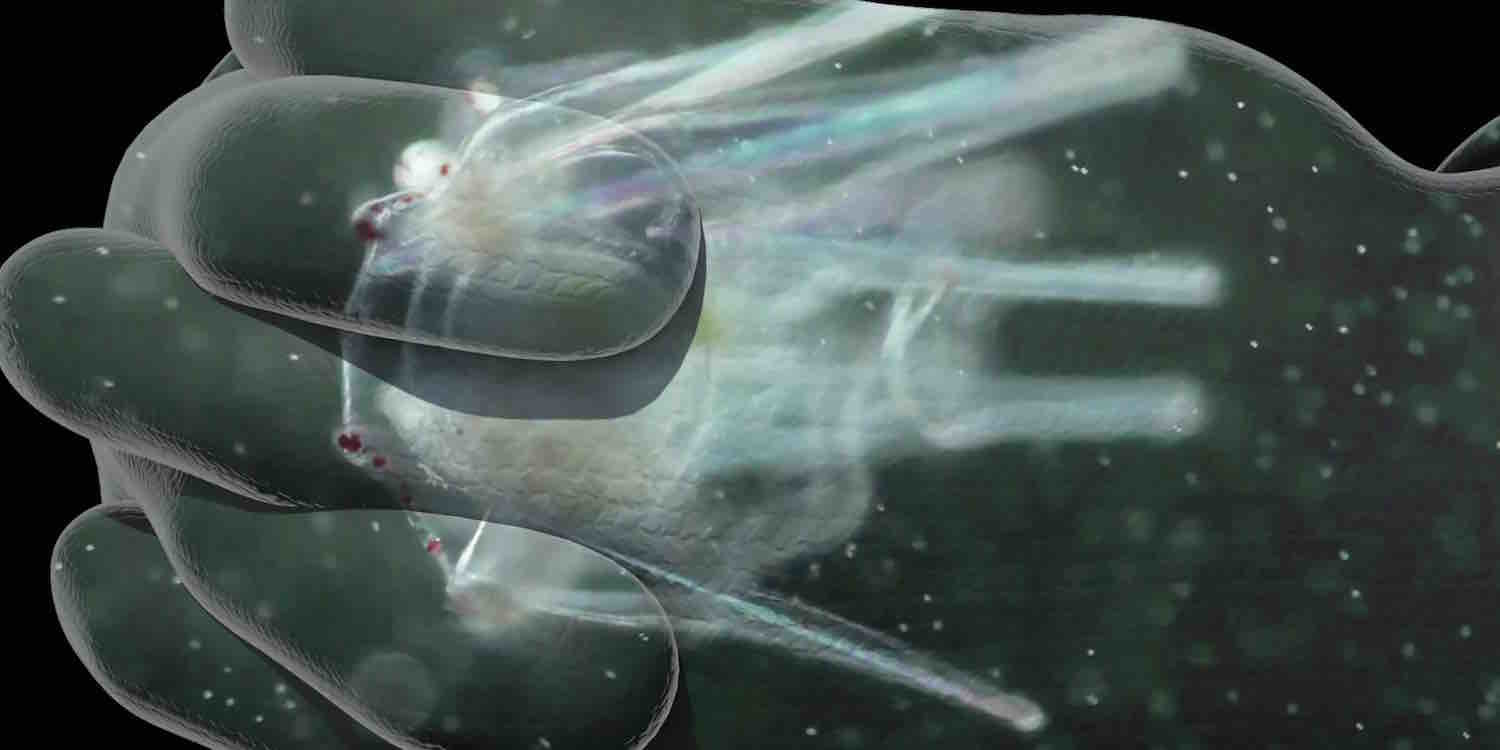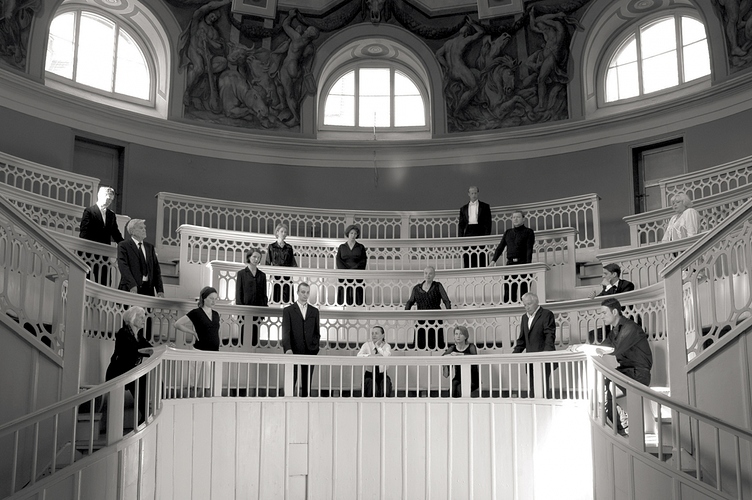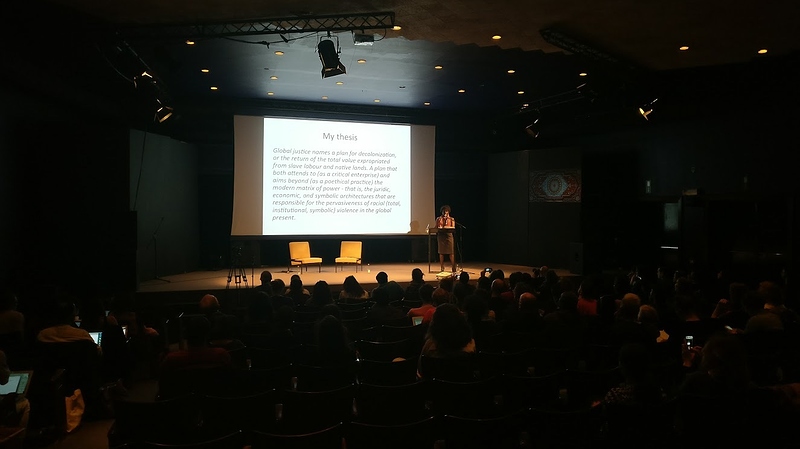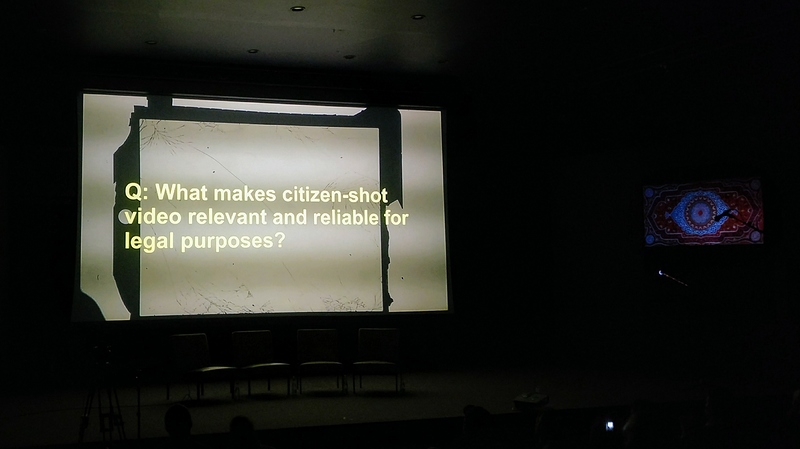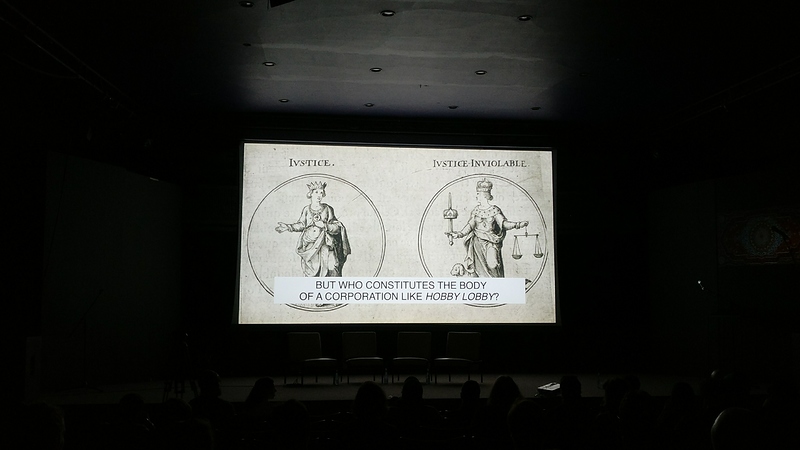Susan Schuppli, Trace Evidence, videostill, HD video, colour with 4-channel sound, 53 mins., 2016
Now, artist Susanne Winterling is speaking about her ongoing research project on the phenomenon of marine bioluminescence. She links bioluminescence to “the planetary system for navigation, spiritual and emotional power.” She takes as example a new specie of toxic algae to trace the relationship between ecology, political unrests and neoliberal societies. In an associative manner, Winterling uses her intervention to reflect on motoring systems to anticipate climate hazards and focalize the many symptoms of systemic violence arising from what she calls ‘ecocide.’ She also called for the necessity of indigenous forms of knowledge to merge with Western scientific epistemology.
Here’s a recent interview with the artist:http://www.kunstkritikk.com/artikler/ten-questions-susanne-winterling/
Here’s a link to a panel discussion with Susanne Winterling, moderated by curator Natasha Ginwala on the occasion of the exhibition Shadow Scenes curated by Ginwala as part of the Cinnamon Colomboscope 2015 Festival: https://www.youtube.com/watch?v=wjqD0OQLrlk

Susanne Winterling, Ecologies (microlevel solidarity lab), mixed media 2014
Susanne Winterling, Vertex Still, digital print on plexiglas, 2015
Artist Ana Torfs discusses her work Anatomy (2006). The talk itself is a theatricalisation of an essay, which has been transformed into speech and footnoted by a looping slideshow. Torfs’ work is one of many contributions within the biennale - weI think here of Rana Hamadeh and Judy Radul - which work with modes of theatricalisation in relation to the law. Or, to put it another way, which take as a premise the notion of the court as theatre. From this position it comes possible to question the fiction of judicial processes themselves - something taken up earlier in the day by Susan Schuppli when she interrogated who it is that is considered as a subject in recourse to the law.
The talk focuses on Torfs’ research around the Case of the Murder of Dr. Karl Liebknecht and Rosa Luxemburg. During her DAAD residency in 2005, Torf researched the Freiburg Military Archive for its holding of the trial in May 1919. The artist selected statements from the trial to compose “A Tragedy in Two Acts,” the literary script for her installation Anatomy.
The talk moves on to discuss the differences of the Russian and French revolution in relation to the German one. Using the case of Luxemburg and Liebknecht, Torfs demonstrates how the German Revolution merely melted in the leader and could not really make any change on a social level. The government worked to suppress the revolution in Germany using different means, such as military commands and private founders, which were instrumentalised in the murder of Luxemburg and Liebknecht.
Torfs poses the questions: How can buildings and textual records (documents) play a role of evidence? How does their materiality, in a conversational sense, pretend the role of justice taking form? This was particularly well articulated by Torfs when she outlined her difficulty in viewing the archive. She retold how some of the documents literally fell to pieces on the table. Under these conditions, how can such documents be an evidence of history, but also, in the same time, a means of erasing that same history? Torfs’ concludes the talk by drawing a connection to the anatomical theatre and the law - of which “subject dissection” is central to both.
Here’s a link a conversation that took place over e-mail in 2006 between art historian Els Roelandt and visual artist Ana Torfs, on the occasion of the first exhibition of Torfs’ installation Anatomy at daadgalerie in Berlin, and republished in the Contour Biennale 8 journal Hearings: http://hearings.contour8.be/2016/09/30/a-tragedy-in-two-acts
Ana Torfs, Anatomy, Slide photograph, 2006
Great presentation by artist Judy Radul, who uses her time to verbalise her ongoing interest in the technologization of the courtroom. Her practice unpacks how surveillance technologies operate within the actual courtroom. Radul notes that there are several levels for considering camera in courts; from pre-testimony and courts cinematography to the framing produced by the camera’s position within the court. She underlines the significance of this through discussing the orientation and disorientation that a moving camera can provide.
Radul frames the camera as a tool which can be easily manipulated by the human operating it. This is an important note as it reveals the overarching question of Radul’s research: the contradiction between the importance of video-evidence but also its potential misuse. Radul articulates this as being the paradox of forms where the aesthetic is not considered in relation to beauty, but instead as a space for experimentation and declarations of authority.
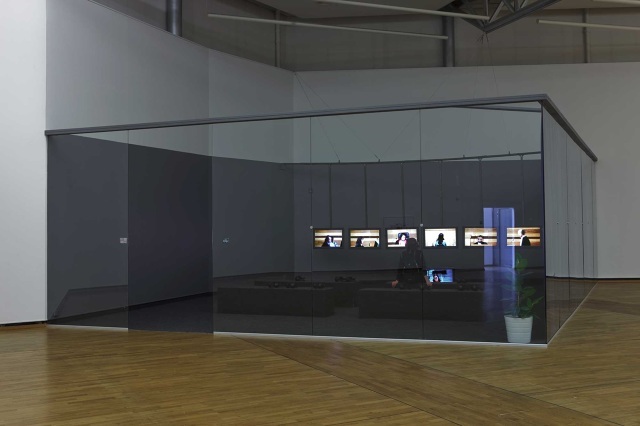
Judy Radul, World Rehearsal Court, Installation view, 2009
Sven Lütticken’s talked seemed to summarise key points that were brought up during the day. He mainly took up the question of personhood in relation to the theatricality of law. He pointed out that trials remake realities. He frames this as the trial as being both theatre and factory - the production of realities materialising in the process of giving evidence and the real world ramifications this may have. Essentially, he addresses the role that fiction plays in judicial arguments.
Lütticken’s inference on the natural order having recourse to the law produced a series of questions. To what extent can, say, a natural instance like a tree, have personhood in the law? This connected again to Susan Schuppli’s talk, but moved on from just proposing, to attempting to articulate the limitations of this in action. He framed this with noting that the notion of subjecthood has never been universal in relation to the law, so it is not about making it universal but contesting subjecthood altogether. As raised in one of the questions during the panel discussion, would it get to the point that a human can sue an ocean for drowning another human? This limitation to the argument seemed relatively unanswered. Can art perform or reenact the theatricality of law and use the specific speech to act or reproduce the real? Can such productions of reenactments give agency to the public?
Council is presenting the project The Against Nature Journal, with a series of contributions from Aimar Arriola, Grégory Castéra, Carlos Motta, Buenos Tiempos, Int. (Alberto García del Castillo and Marnie Slater), and students from the Dutch Art Institute (DAI). _Council_was founded in 2013 by Grégory Castéra and Sandra Terdjman. Here’s a link to their website:http://www.formsofcouncil.org/en/.
The different presentations spoke to gender identity and embodiments of queerness. They took different forms - we were particularly taken by Carlos Motta’s video, Deseos (2015). The video is a letter exchange between two women, Martina and Noor, who are living in Santa Fe and Beirut in 1804.
Carlos Motta, Deseos, video still, 2015
Carlos Motta, Deseos, Screening at Contour Biennale, Mechelen, 2017
Here’s a link to Motta’s video: https://vimeo.com/127254583
An immediate thought about the visuals: there is a beautiful moment that shows a pearl in the long black hair of Aisha (who we presume to be Noor’s lover). It reminds us of the scene in the novel The Fingersmith by Sarah Waters. Book spoiler alert: the point when the two women finally sleep together is a highly charged sexual moment, and barely described. When one of the women comes, she cries out ‘You pearl’. It’s so sexual and yet the author describes nothing. Same as this film. A slow-moving camera pans across contemporary landscapes (or rather, landscapes that are signposted as shot in the present day): graffitied walls, a road sign along a highway, an abandoned house, a mountain scene, a little bird in an orange cage etc.
Something else that stood out was the performance called Strictly Ballroom by Buenos Tiempos, Int. 
But first a disclaimer: today’s symposium is taking place in a converted church. The venue is called the Holy Ghost.
The performers utter and repeat Hey you, what you gonna do when God dies? And when they do, the overhead lights in the venue, which is really and truly a church, come on. The lights flicker and then turn off again. Is God trying to tell us something? Is art a big sham? Is the Lord Almighty pissed off at us? The biennial opening took place in this very location last night. Everyone drank free beer. Here in the place of the Lord. Lord have mercy on us and our hangovers.
Live performance Strictly Ballroom by Buenos Tiempos, Int. at Contour Biennale 8, Mechelen 2017
Before our next drink, we move on to the last presentation of the day, a lecture performance by artists Filipa César and Louis Henderson.
 Yippee!
Yippee! 
And, now…Filipa César & Louis Henderson’s lecture performance Refracted Spaces: An Archeology of Optics which expands on their research project on the study of historical methods of optical navigation and new algorithm of locating. The artists imagine the lighthouse lens as a departing point to develop a critique of Western epistemology, or what, in conversation with co-curator of the public programme Rachel O’Reilly, the artist Filipa César describes as the act of ‘decolonizing the lighthouse.’ Against the Enlightened ideals of clarity and transparency, the artists call for a politics of opacity.
Here’s a link to Louis Henderson’s contribution to the Contour Biennale 8 journal, Hearings: http://hearings.contour8.be/2016/08/05/america-de-bry-1590-1634/
Filipa César & Louis Henderson, Sunstone, production still, 2017.
Research image for a ciné-conversation between Filipa César and Louis Henderson, 2016.
It’s all for today. It has been a long and inspiring day of presentations.
See you tomorrow for the second part of the symposium!
Bonjour! We’re ready to start Day Two of the Contour Biennale 8 Public Programme / DAI Roaming Assembly #12. We’ll be coming at you from Cultural Centre Mechelen. The program begins with a video screening by inhabitants made in collaboration with Filipa César and Louis Henderson. Curator Natasha Ginwala is now introducing the day…
In anticipation of Denise Ferreira da Silva’s keynote address, here she is talking about Hacking the Subject: Black Feminism, Refusal, and the Limits of Critique https://www.youtube.com/watch?v=T3B5Gh2JSQg
Denise Ferreira da Silva’ s presentation
Denise Ferreira da Silva, Notes Toward a Theory of Transformative Justice, Contoure Biennale 8 Mechelen, 2017
Inspiring lecture by Denise Ferreira da Silva! She opens with the statement that a theory of justice, including transformative justice, cannot rely on modern knowledge and its tools. Before laying out her thesis on a global justice that is grounded in racial and cultural difference, she outlines justice theories. As she remarks, her concept of the racial event is as reaction to Badiou’s notion of the event, and to his students who have emancipated the object from subject.
Da Silva’s outlines her thesis for global justice and names the aim for decolonization as the return of the total value expropriated from slave labor and native lands. She continues by stating that it needs to be more than just calling a regime for what it is, say racist or sexist, and instead proposes the speculative approach of thinking in terms of ‘what if’ as the way to move beyond an idea of justice in which the subject is central.
She calls for a transformative theory of justice that can only come from the perspective of the global. The example she gave was of a sinking boat full of immigrants, detailing the transpiring of events for a woman and her attempts to save her baby. She says: ‘and the rest is the news’. Such a comment alludes to her breakdown of the racial event as one being not defined by the materiality of race, but instead one in relation to rights. This is a key point as she noted the term ‘rights’ is to law what the term liberty is to society. The racial event is defined as containing elements in which a subject becomes object in the face of racial difference. Da Silva argues that the current image of justice in relation to scientific truth is not sufficient in catering to cultural difference. From her intervention, it is possible to contend that Da Silva proposes that in order to enact a transformative theory of justice, we need to move away from 16th and 17th century notions of man’s separability from nature, and begin to imagine different scenario, to adopt a speculative way of thinking, the ‘what if’. That’s why the role of art is important. In her intervention, Denise Ferreira da Silva presents a critique of modern thought that shows how racial knowledge and power produce global space. Silva proposes that the notion of racial difference governs the global power configuration because it institutes moral regions not covered by post-Enlightenment ethical ideals.
Ferreira da Silva is now in conversation with Natasha Gimwala, and clearly loving the ‘what if’ possibilities of being within the art context, rather than the academy. She says, ‘There is no such thing as a black light that can be thrown over the subject… But why not? What if the minerals instead of glittering, what if they could glitter the darkness that is never appreciated when looked at?’
More here: http://www.e-flux.com/journal/79/94686/1-life-0-blackness-or-on-matter-beyond-the-equation-of-value/
Some important questions were asked by audience members during the opening session. Someone asked Denise Ferreira da Silva to elaborate on her idea of global justice and how it differs/relates to Deleuze’s work on jurisprudence, especially his argument against universal rights and for immanent rights. Ferreira da Silva responded by arguing that for her it is not possible to assume that there is a subjectivity which is yet to be liberated from its actual condition of existence. There is no subject who is already free and needs protection.
Someone else asked another question regarding possible alternatives to the idea of justice which implies the existence of a free subject. Da Silva said that there is a need to dissolve existing forms such as the idea of the freedom of the subject, and that > we need to know the world anew. We must engage with existence in a way that is different from how European philosophers have addressed it in terms of separability of men and other entities.
A couple of behind the scenes shots from the tarot reading Denise Ferreira da Silva did for the Dutch Art Institute class during her guest tutorial on Friday, 10 March 2017. Images courtesy Clementine Edwards.
Notes in the margins of Denise Ferreira da Silva’s ‘On Difference without Separability’, written for the catalogue of the 32a São Paulo Art Biennial, “Incerteza viva” (Living Uncertainty).
Our reflection on how her keynote address complements the essay to follow later. Read the full text in the meantime: https://issuu.com/amilcarpacker/docs/denise_ferreira_da_silva
Silva writes against the subjectivity that is defined by liberty. She sees the global political context as one organised by racial difference. That difference is a tool used to produce the white European subject entitled to liberty, and its Other who have traits that mark them as intrinsically violent and as non-free subjects. So of course understandings of liberty play into this.
‘Humanity has a racial aspect, and so we need to dissolve the forms of the subject as conveyed in the principle of liberty. They’re so inherent to what we do that it’s almost impossible to come up with examples that operate outside of the paradigm. We need to know the world anew. We need to begin our engagement with existence in a way that is completely different to how the European philosophers did. We need to begin without the concept of separability.’
We start again after the lunch break with the screening of the video The Reproduction of Personhood, by inhabitans. Can online video constitute a source of evidence in court cases? The video brilliantly looks at video-recording technologies, social justice and human right activism.
Co-curator of the Contour Biennale 8 Public Programme, writer Rachel O’Reilly introduces the afternoon session Deceptive Authoritarianisms:Between Artificial and Discredited Personhood, followed by a brief introduction by Pedro Neves Marques from the inhabitants.
Now Mariana Silva from the inhabitants is discussing the case of Hobby Lobby a corporation which has been granted personhood and religious rights.
From wiki:
In September 2012, Hobby Lobby filed a lawsuit against the United States over new regulations requiring health insurance provided by employers to cover emergency contraceptives, stating: “(t)he Green family’s religious beliefs forbid them from participating in, providing access to, paying for, training others to engage in, or otherwise supporting abortion-causing drugs and devices”. Hobby Lobby argued that the Free Exercise Clause of the First Amendment to the United States Constitution and the Religious Freedom Restoration Act serve to protect their religious beliefs, and accordingly bars the application of the contraceptive mandate to them. The U.S. Supreme Court rejected the company’s application for an injunction, prompting the firm to sue the federal government. On July 19, 2013, US District Judge Joe Heaton granted the company a temporary exemption from the contraceptive-providing mandate.
In contrast, on January 28, 2014, the Centre for Inquiry filed an amicus brief with the Supreme Court arguing that were the court to grant Hobby Lobby an exclusion which permitted the company to exclude any specific healthcare service from its provision to employees on the basis of the owners’ religious beliefs, the firm would violate the Establishment Clause, also part of the First Amendment. The Establishment Clause states: “Congress shall make no law respecting an establishment of religion”.
Oral arguments in the case, then known as Sebelius v. Hobby Lobby, were heard on March 25, 2014.
